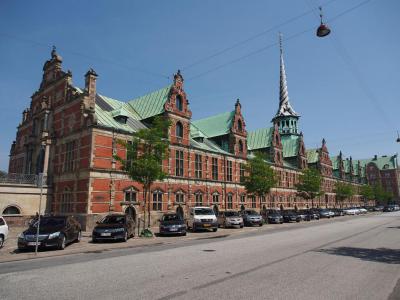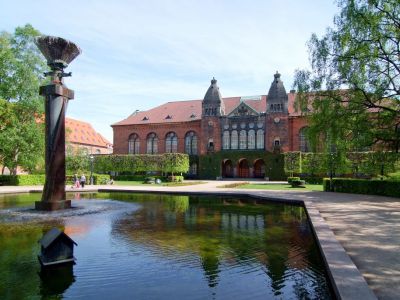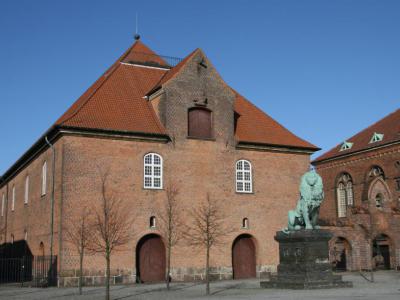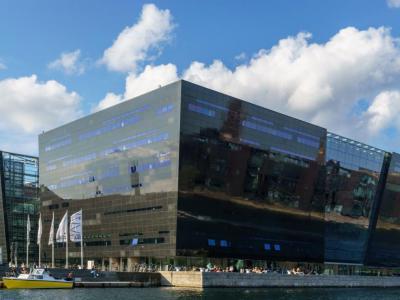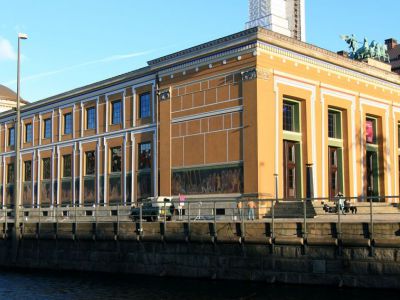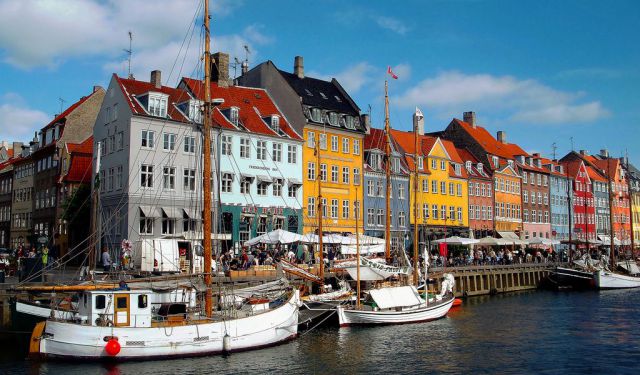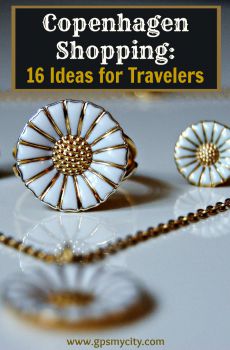
Castle Island (Slotsholmen) Walking Tour (Self Guided), Copenhagen
Traditionally seen as the birthplace of Copenhagen, Castle Island (Slotsholmen) gave rise to the Danish capital with a small fortress built on it in the 12th century AD. Since the Middle Ages, this area, also known as the "Island of Power," has been the center of Denmark's government. It houses several prominent landmarks that played significant roles in the country's history.
The imposing Christiansborg Palace is the seat of the Danish Parliament, the Supreme Court, and the Prime Minister's Office. Architecturally impressive, it serves as the symbol of Danish governance.
The Old Stock Exchange, with its distinctive spire adorned by four entwined dragon tails, is a fascinating historical edifice that once accommodated the local stock exchange. Its quaint design adds to the island's charm.
The Royal Library (Kongelige Bibliotek) is a treasure trove of knowledge, containing countless books, manuscripts, and historical documents – a true haven for scholars and history enthusiasts.
The Danish War Museum (Krigsmuseet) offers a glimpse into Denmark's military history, showcasing an impressive collection of artifacts, weapons, and memorabilia from various wars.
The Black Diamond, a modern addition to the Royal Library, stands out with its sleek, black façade, gleaming like a diamond. Inside, you'll find exhibitions, events, and a world-class library collection.
Christian IV's Brewhouse, otherwise known as Kongernes Lapidarium, is a museum filled with sculptures and artifacts from Danish history, providing insight into the nation's royal heritage.
The Marble Bridge (Marmorbro) is an elegant bridge connecting Castle Island to the rest of Copenhagen, offering stunning views of the cityscape and the waterfront.
Lastly, Thorvaldsens Museum is a tribute to the famous Danish neoclassical sculptor Bertel Thorvaldsen. It houses a collection of his sculptures and works of art.
Nowadays, this compact island is a great place to escape the crowds and take photos of splendid architecture. A step onto Castle Island offers a chance to explore the past, appreciate art, and soak in the beauty of Copenhagen. So, take this step now with our self-guided tour and enjoy the experience at your own pace!
The imposing Christiansborg Palace is the seat of the Danish Parliament, the Supreme Court, and the Prime Minister's Office. Architecturally impressive, it serves as the symbol of Danish governance.
The Old Stock Exchange, with its distinctive spire adorned by four entwined dragon tails, is a fascinating historical edifice that once accommodated the local stock exchange. Its quaint design adds to the island's charm.
The Royal Library (Kongelige Bibliotek) is a treasure trove of knowledge, containing countless books, manuscripts, and historical documents – a true haven for scholars and history enthusiasts.
The Danish War Museum (Krigsmuseet) offers a glimpse into Denmark's military history, showcasing an impressive collection of artifacts, weapons, and memorabilia from various wars.
The Black Diamond, a modern addition to the Royal Library, stands out with its sleek, black façade, gleaming like a diamond. Inside, you'll find exhibitions, events, and a world-class library collection.
Christian IV's Brewhouse, otherwise known as Kongernes Lapidarium, is a museum filled with sculptures and artifacts from Danish history, providing insight into the nation's royal heritage.
The Marble Bridge (Marmorbro) is an elegant bridge connecting Castle Island to the rest of Copenhagen, offering stunning views of the cityscape and the waterfront.
Lastly, Thorvaldsens Museum is a tribute to the famous Danish neoclassical sculptor Bertel Thorvaldsen. It houses a collection of his sculptures and works of art.
Nowadays, this compact island is a great place to escape the crowds and take photos of splendid architecture. A step onto Castle Island offers a chance to explore the past, appreciate art, and soak in the beauty of Copenhagen. So, take this step now with our self-guided tour and enjoy the experience at your own pace!
How it works: Download the app "GPSmyCity: Walks in 1K+ Cities" from Apple App Store or Google Play Store to your mobile phone or tablet. The app turns your mobile device into a personal tour guide and its built-in GPS navigation functions guide you from one tour stop to next. The app works offline, so no data plan is needed when traveling abroad.
Castle Island (Slotsholmen) Walking Tour Map
Guide Name: Castle Island (Slotsholmen) Walking Tour
Guide Location: Denmark » Copenhagen (See other walking tours in Copenhagen)
Guide Type: Self-guided Walking Tour (Sightseeing)
# of Attractions: 8
Tour Duration: 1 Hour(s)
Travel Distance: 1.6 Km or 1 Miles
Author: EmmaS
Sight(s) Featured in This Guide:
Guide Location: Denmark » Copenhagen (See other walking tours in Copenhagen)
Guide Type: Self-guided Walking Tour (Sightseeing)
# of Attractions: 8
Tour Duration: 1 Hour(s)
Travel Distance: 1.6 Km or 1 Miles
Author: EmmaS
Sight(s) Featured in This Guide:
- Christiansborg Palace
- Old Stock Exchange (Borsen)
- Royal Library (Kongelige Bibliotek)
- Danish War Museum (Krigsmuseet)
- Black Diamond (Royal Library)
- Christian IV's Brewhouse / Kongernes Lapidarium
- Marble Bridge (Marmorbro)
- Thorvaldsens Museum
1) Christiansborg Palace (must see)
Christiansborg Palace is where Danish democracy, royal pomp, and a bit of architectural resilience come together. This place isn’t just a palace but the unicorn of government buildings. It’s the only structure in the world that houses all three branches of government: the Parliament, the Prime Minister’s Office, and the Supreme Court. Talk about multitasking...
The current palace is the third on this site. The original castle built by the city's founder, Bishop Absalon, stood here since 1167. Its remains, along with those of its successor – Copenhagen Castle – have been excavated and are now visible in the subterranean section at Christiansborg. After suffering two major fires, in 1794 and 1884, the palace was rebuilt in a historicist Neo-baroque style by 1928.
Often called "the Castle of the Realm" or simply "the Castle", Christiansborg is also used by the Danish monarchy, hosting dignitaries in its lavish Royal Reception Rooms, holding ceremonies in the Palace Chapel, and presumably waving regally at horses in the Royal Stables.
Speaking of horses—here’s a bit of drama. King Christian IX's equestrian statue at the Riding Ground Complex, unveiled in 1927, caused controversy. The horse model for it was sourced from Hanover, Germany, thus causing discontent among Danish breeders.
Owned by the Danish Government, parts of Christiansborg are open to the public. If you have a Copenhagen Card for tourists, admission to the royal reception rooms (as well as the stables, kitchen, and underground ruins) is free. Highlights of the experience include the Queen's china collection, her ornate ceremonial library, and the Great Hall, adorned with tapestries chronicling Denmark's history.
But even if you don't have the card, no problem. You can still wander the courtyard and head up the Tower—Copenhagen’s tallest. The views are impeccable. The elevator—tiny but mighty. And the security check is mildly official.
Tip:
Always look out for the free English one-hour tours included in your ticket (they run at 3 pm each day but also at different times during weekends: 12 pm or 2pm). That is of course unless you'd rather wander the rooms on your own, reading the descriptions.
The current palace is the third on this site. The original castle built by the city's founder, Bishop Absalon, stood here since 1167. Its remains, along with those of its successor – Copenhagen Castle – have been excavated and are now visible in the subterranean section at Christiansborg. After suffering two major fires, in 1794 and 1884, the palace was rebuilt in a historicist Neo-baroque style by 1928.
Often called "the Castle of the Realm" or simply "the Castle", Christiansborg is also used by the Danish monarchy, hosting dignitaries in its lavish Royal Reception Rooms, holding ceremonies in the Palace Chapel, and presumably waving regally at horses in the Royal Stables.
Speaking of horses—here’s a bit of drama. King Christian IX's equestrian statue at the Riding Ground Complex, unveiled in 1927, caused controversy. The horse model for it was sourced from Hanover, Germany, thus causing discontent among Danish breeders.
Owned by the Danish Government, parts of Christiansborg are open to the public. If you have a Copenhagen Card for tourists, admission to the royal reception rooms (as well as the stables, kitchen, and underground ruins) is free. Highlights of the experience include the Queen's china collection, her ornate ceremonial library, and the Great Hall, adorned with tapestries chronicling Denmark's history.
But even if you don't have the card, no problem. You can still wander the courtyard and head up the Tower—Copenhagen’s tallest. The views are impeccable. The elevator—tiny but mighty. And the security check is mildly official.
Tip:
Always look out for the free English one-hour tours included in your ticket (they run at 3 pm each day but also at different times during weekends: 12 pm or 2pm). That is of course unless you'd rather wander the rooms on your own, reading the descriptions.
2) Old Stock Exchange (Borsen)
Once known as "the commodity bourse"—because "stock exchange" didn’t sound quite grand enough in the 17th century—this building was constructed between 1619 and 1640 by two Flemish-Danish architects who clearly wanted to show off a bit. In essence, this red-brick beauty was King Christian IV’s way of saying, “Hey, Europe, Copenhagen means business.”
Its long waterfront façade was basically a fancy welcome mat for merchants sailing in from afar. Styled in the Dutch Renaissance fashion—with all its ornate gables and scrolls—it quickly became a symbol of the city’s ambition to be the trading capital of Northern Europe.
But what really turned their heads was that wild Dragon Spire! Imagine the tails of four dragons braided together, topped with crowns like a scaly Scandinavian power move. This symbolism was a nod to the union of Denmark, Norway, and Sweden… and maybe a subtle hint that Copenhagen wouldn’t mind being the emperor of trade in the north.
The spire originally went up in 1625 but was swapped out in 1775 for a sturdier version. According to legend, it kept the building safe from fire and enemies—like a very pointy good luck charm. And for centuries, it worked. Even as neighboring buildings were reduced to ashes, the Bourse stood tall… until April 16, 2024.
On that day, during renovation works, flames got the better of it. Half the building was lost, and the iconic spire came crashing down. Denmark mourned, comparisons to Notre Dame flew, and officials quickly vowed, “We’ll rebuild it!”
And while that phoenix moment is still ahead, you can check out the spires over in Christian's Harbor—Copenhagen’s own “Little Amsterdam.” They’ve got flair of their own.
Tip:
If you want the perfect photo of the Bourse (or what's left of it), take the elevator in Christiansborg Palace across the street. It’s got a killer view. And if you're itching to see inside the Bourse, mark your calendar for Culture Night in October. But brace yourself—the lines are long because, apparently, exclusive historical architecture is still very much in.
Its long waterfront façade was basically a fancy welcome mat for merchants sailing in from afar. Styled in the Dutch Renaissance fashion—with all its ornate gables and scrolls—it quickly became a symbol of the city’s ambition to be the trading capital of Northern Europe.
But what really turned their heads was that wild Dragon Spire! Imagine the tails of four dragons braided together, topped with crowns like a scaly Scandinavian power move. This symbolism was a nod to the union of Denmark, Norway, and Sweden… and maybe a subtle hint that Copenhagen wouldn’t mind being the emperor of trade in the north.
The spire originally went up in 1625 but was swapped out in 1775 for a sturdier version. According to legend, it kept the building safe from fire and enemies—like a very pointy good luck charm. And for centuries, it worked. Even as neighboring buildings were reduced to ashes, the Bourse stood tall… until April 16, 2024.
On that day, during renovation works, flames got the better of it. Half the building was lost, and the iconic spire came crashing down. Denmark mourned, comparisons to Notre Dame flew, and officials quickly vowed, “We’ll rebuild it!”
And while that phoenix moment is still ahead, you can check out the spires over in Christian's Harbor—Copenhagen’s own “Little Amsterdam.” They’ve got flair of their own.
Tip:
If you want the perfect photo of the Bourse (or what's left of it), take the elevator in Christiansborg Palace across the street. It’s got a killer view. And if you're itching to see inside the Bourse, mark your calendar for Culture Night in October. But brace yourself—the lines are long because, apparently, exclusive historical architecture is still very much in.
3) Royal Library (Kongelige Bibliotek)
The Royal Library in Copenhagen is Denmark’s answer to the question: How many books is too many? (They haven’t found the limit yet.)
This literary leviathan is both the national library of Denmark and the library for the University of Copenhagen. It is also one of the largest libraries in the world and easily the biggest in the Nordics.
It all began in 1648, when King Frederik III decided he really liked books—so much so, he started a library and filled it with Europe’s finest. By 1793, the place was open to the public, making it officially the most cultured hangout in the city.
A few centuries later—and after several mergers—the Royal Library absorbed just about every major library in sight: the University Library, the Danish National Library for Science and Medicine, the Danish Folklore Archive, and finally, in 2017, it joined forces with the State and University Library in Aarhus. Now, it reigns supreme as the Royal Danish Library, operating out of both Copenhagen and Aarhus, like a literary superhero with two lairs.
Inside are as many as 37 million physical items, over 2.4 million e-titles, manuscripts, music scores, maps, photos, rare prints, and four annual digital snapshots of the entire Danish internet. Yes, Denmark backs up its memes...
You can enter this bookish empire through the sleek and shiny modern wing known as the Black Diamond. Hop on the escalator inside—it’ll whisk you up into the old section, which is worth the detour just for its majestic interiors. Every Saturday at 3 pm, they offer public tours of the Black Diamond (for a fee, but hey—knowledge always comes at a price).
There’s also a cafe that serves up coffee with a side of river views, outdoor seating when the sun’s feeling generous, and a restaurant called Søren K. Don’t forget the gift shop—you might just find the perfect bookmark to go with your existential crisis there.
So, go ahead, wander in, and don’t expect to leave without having learned something...
This literary leviathan is both the national library of Denmark and the library for the University of Copenhagen. It is also one of the largest libraries in the world and easily the biggest in the Nordics.
It all began in 1648, when King Frederik III decided he really liked books—so much so, he started a library and filled it with Europe’s finest. By 1793, the place was open to the public, making it officially the most cultured hangout in the city.
A few centuries later—and after several mergers—the Royal Library absorbed just about every major library in sight: the University Library, the Danish National Library for Science and Medicine, the Danish Folklore Archive, and finally, in 2017, it joined forces with the State and University Library in Aarhus. Now, it reigns supreme as the Royal Danish Library, operating out of both Copenhagen and Aarhus, like a literary superhero with two lairs.
Inside are as many as 37 million physical items, over 2.4 million e-titles, manuscripts, music scores, maps, photos, rare prints, and four annual digital snapshots of the entire Danish internet. Yes, Denmark backs up its memes...
You can enter this bookish empire through the sleek and shiny modern wing known as the Black Diamond. Hop on the escalator inside—it’ll whisk you up into the old section, which is worth the detour just for its majestic interiors. Every Saturday at 3 pm, they offer public tours of the Black Diamond (for a fee, but hey—knowledge always comes at a price).
There’s also a cafe that serves up coffee with a side of river views, outdoor seating when the sun’s feeling generous, and a restaurant called Søren K. Don’t forget the gift shop—you might just find the perfect bookmark to go with your existential crisis there.
So, go ahead, wander in, and don’t expect to leave without having learned something...
4) Danish War Museum (Krigsmuseet)
Now here’s a fun twist in Danish history: one of the very few buildings in Denmark still doing exactly what it was built for—minus the explosions. Welcome to the old Arsenal, one of King Christian IV’s many ambitious pet projects. Back in the day, it was a cozy little home for hand weapons and cannons. Today, it is still all about the bang—but with more context and zero casualties. Say hello to the Danish War Museum!
Tucked inside this Renaissance power statement is a treasure trove of military history. Think shiny old swords, grumpy-looking cannons, and a full-scale walk-in diorama of a NATO station in Afghanistan—because who doesn’t want to time travel through global conflict while safely avoiding sand in their shoes?
The building itself is a bit of a show-off. It's a monument to how the Renaissance established itself in Copenhagen and gave royal authority a stylish stone-clad makeover. Step into the grand Arsenal Hall—stretching a jaw-dropping 156 meters long, making it the largest arched Renaissance hall in Europe. Basically a catwalk for antique weaponry, here, you can feast your eyes on more Danish cannons than you can count without getting dizzy.
Elsewhere, you can trace the dramatic glow-up of edged weapons and firearms over the past 500 years. From ornate princely pistols to tough-as-nails war trophies, the collection delivers style and firepower in equal measure.
Oh, and don’t skip the 19th-century military fashion section. We’re talking about banners, uniforms, armor, and saddles that could make even the grumpiest general look fabulous.
So, if you're into history, heavy metal (literally), or just enjoy buildings that know how to age gracefully—this one’s not to be missed.
Tucked inside this Renaissance power statement is a treasure trove of military history. Think shiny old swords, grumpy-looking cannons, and a full-scale walk-in diorama of a NATO station in Afghanistan—because who doesn’t want to time travel through global conflict while safely avoiding sand in their shoes?
The building itself is a bit of a show-off. It's a monument to how the Renaissance established itself in Copenhagen and gave royal authority a stylish stone-clad makeover. Step into the grand Arsenal Hall—stretching a jaw-dropping 156 meters long, making it the largest arched Renaissance hall in Europe. Basically a catwalk for antique weaponry, here, you can feast your eyes on more Danish cannons than you can count without getting dizzy.
Elsewhere, you can trace the dramatic glow-up of edged weapons and firearms over the past 500 years. From ornate princely pistols to tough-as-nails war trophies, the collection delivers style and firepower in equal measure.
Oh, and don’t skip the 19th-century military fashion section. We’re talking about banners, uniforms, armor, and saddles that could make even the grumpiest general look fabulous.
So, if you're into history, heavy metal (literally), or just enjoy buildings that know how to age gracefully—this one’s not to be missed.
5) Black Diamond (Royal Library)
Whenever you hear “the Black Diamond” in Copenhagen, don't think of some James Bond villain’s lair or a secret club for architects with impeccable taste. No, this is one of the city’s glimmering jewels of modern design, perched glamorously on the waterfront.
Unveiled in 1999 and dreamed up by the stylish minds at Schmidt Hammer Lassen Architects, the Black Diamond is the flashy, prismatic younger sibling of the Royal Danish Library. Its sleek black granite façade—sourced from Zimbabwe, polished in Italy, and clearly moisturized better than most of us—gleams seductively in the sun, mirroring both the sea and sky with just the right amount of drama.
Inside, you are greeted by a soaring glass atrium that feels more like a spaceship hangar than a library hallway. It’s where the future shakes hands with the past, linking this glossy new wing with the elegant 1906 original building.
And no—this isn’t just a temple to books. The Black Diamond is also a full-blown cultural hotspot. Onsite exhibitions feature everything from medieval manuscripts to edgy contemporary art. For concerts and readings, check out The Queen’s Hall, where 600 viewers at a time can enjoy performances that range from literary to symphonic, often in the same week.
And for a bit of sonic surprise, be there at 1 pm when the atrium itself starts to sing. Wayne Siegel’s sound art piece “Sky Mechanics” pipes through the space, a dynamic composition influenced by the lunar cycle.
For extra fun, there’s a café where the lattes come with a side of harbor view, a bookshop brimming with quote-covered goodies, and guided tours for those who like their architecture with a side of trivia.
Bonus round: Just behind the Diamond, you’ll find the Royal Library Garden. It’s a poetic little nook filled with greenery, a pond, and none other than philosopher Søren Kierkegaard in bronze, brooding thoughtfully—probably over Danish existentialism or what’s for lunch.
Indeed, the Black Diamond is where Copenhagen’s intellect puts on its sharpest suit and sparkles unapologetically.
Unveiled in 1999 and dreamed up by the stylish minds at Schmidt Hammer Lassen Architects, the Black Diamond is the flashy, prismatic younger sibling of the Royal Danish Library. Its sleek black granite façade—sourced from Zimbabwe, polished in Italy, and clearly moisturized better than most of us—gleams seductively in the sun, mirroring both the sea and sky with just the right amount of drama.
Inside, you are greeted by a soaring glass atrium that feels more like a spaceship hangar than a library hallway. It’s where the future shakes hands with the past, linking this glossy new wing with the elegant 1906 original building.
And no—this isn’t just a temple to books. The Black Diamond is also a full-blown cultural hotspot. Onsite exhibitions feature everything from medieval manuscripts to edgy contemporary art. For concerts and readings, check out The Queen’s Hall, where 600 viewers at a time can enjoy performances that range from literary to symphonic, often in the same week.
And for a bit of sonic surprise, be there at 1 pm when the atrium itself starts to sing. Wayne Siegel’s sound art piece “Sky Mechanics” pipes through the space, a dynamic composition influenced by the lunar cycle.
For extra fun, there’s a café where the lattes come with a side of harbor view, a bookshop brimming with quote-covered goodies, and guided tours for those who like their architecture with a side of trivia.
Bonus round: Just behind the Diamond, you’ll find the Royal Library Garden. It’s a poetic little nook filled with greenery, a pond, and none other than philosopher Søren Kierkegaard in bronze, brooding thoughtfully—probably over Danish existentialism or what’s for lunch.
Indeed, the Black Diamond is where Copenhagen’s intellect puts on its sharpest suit and sparkles unapologetically.
6) Christian IV's Brewhouse / Kongernes Lapidarium
Nestled right in the heart of the city, on Castle Island, is the Lapidarium of Kings—a museum where rocks rule, kings strike a pose, and Copenhagen’s royal past comes to life... in stone.
In case you're wondering, “lapidarium” comes from the Latin word lapis, which means stone. The latter is quite fitting since this is basically a stone VIP lounge. Over the centuries, Danish monarchs have decorated their cities with statues to show off a little royal flair—heavily inspired by the French style, naturally. Many of them, eventually affected by the Danish weather, had to be swapped out, so the lapidarium stepped in as their elegant, slightly dusty afterlife.
Inside, you'll find 300 statues and sculptures rescued from Danish royal gardens, palaces, and buildings—a sort of retirement home for royal stonework. There are noble busts, commanding figures, and even plaster models, like the dashing equestrian statue of King Frederick V at Amalienborg or the original statue of Christian V from King's Square—because every king deserves to be remembered on a horse.
And what's peculiar, this sculptural treasure trove is housed in none other than King Christian IV’s 400-year-old brewhouse. Yes, a brewhouse. Because why settle for just beer when you can also store an army of sculptures in your basement?
Once part of the city's military fortifications, this building spans a whopping 8,000 square meters—plenty of room for barrels, battalions, and now, a parade of very still VIPs. After a full royal makeover, it opened its grand doors as a public museum on June 3, 2014.
The best part here is that you’re not just looking at statues from afar. Nope—you get face-to-face with these stone legends. Forget craning your neck from a palace courtyard; now you can meet them at ground level, under vaulted ceilings that practically echo with royal gossip.
So, if you like your history with a bit of weight—literally—this is the place. A royal roll-call carved in stone.
In case you're wondering, “lapidarium” comes from the Latin word lapis, which means stone. The latter is quite fitting since this is basically a stone VIP lounge. Over the centuries, Danish monarchs have decorated their cities with statues to show off a little royal flair—heavily inspired by the French style, naturally. Many of them, eventually affected by the Danish weather, had to be swapped out, so the lapidarium stepped in as their elegant, slightly dusty afterlife.
Inside, you'll find 300 statues and sculptures rescued from Danish royal gardens, palaces, and buildings—a sort of retirement home for royal stonework. There are noble busts, commanding figures, and even plaster models, like the dashing equestrian statue of King Frederick V at Amalienborg or the original statue of Christian V from King's Square—because every king deserves to be remembered on a horse.
And what's peculiar, this sculptural treasure trove is housed in none other than King Christian IV’s 400-year-old brewhouse. Yes, a brewhouse. Because why settle for just beer when you can also store an army of sculptures in your basement?
Once part of the city's military fortifications, this building spans a whopping 8,000 square meters—plenty of room for barrels, battalions, and now, a parade of very still VIPs. After a full royal makeover, it opened its grand doors as a public museum on June 3, 2014.
The best part here is that you’re not just looking at statues from afar. Nope—you get face-to-face with these stone legends. Forget craning your neck from a palace courtyard; now you can meet them at ground level, under vaulted ceilings that practically echo with royal gossip.
So, if you like your history with a bit of weight—literally—this is the place. A royal roll-call carved in stone.
7) Marble Bridge (Marmorbro)
Perhaps Copenhagen’s most photogenic overachiever, the Marble Bridge is undoubtedly the most notable of the four bridges crossing Frederiksholms Kanal. Built in 1744 as part of the original Christiansborg Palace complex, it was meant to impress guests heading to the royal riding grounds. And it certainly did.
Despite the palace burning down not once, but twice, throughout its history, this elegant rococo beauty survived both firestorms with all the grace of a period drama heroine. Today, it remains one of the few original features still standing, looking like it just walked out of the 18th century and refused to age.
Built with Norwegian marble (because, obviously, only the finest materials would fit the purpose) and dressed up with sandstone from Saxony, this bridge is no minimalist. Its creator, Johan Christof Petzoldt, added the royal couple’s monograms and symbolic rooftop figures emphasizing royal virtues. Throw in some lantern-topped columns, marble balustrades, and refined arches, and you’ve got the bridge that was meant to dazzle—and it still does.
Visually striking, the bridge looks like it belongs on a vintage postcard. With the picturesque views of Christiansborg Palace and those charming copper rooftops, it’s a hotspot for tourists, romantics, and anyone who enjoys watching canal boats attempt the very tight squeeze under its arches—some barely make the turn, thus adding a bit of light entertainment for viewers.
However, the bridge is not just about looks—it is part of a richly historical setting. Within a short stroll, you’ve got Christian IV’s Brewhouse, the Danish War Museum, and the royal stables. And if you’re lucky, a horse-drawn carriage might occasionally trot by, contributing to the old-world charm of the area.
In essence, although not massive or flashy, the Marble Bridge holds an iconic presence in Copenhagen. It’s all about quiet confidence, old-world elegance, and some really terrific photo ops. So whenever you’re near Castle Island, make the detour for this perfect pause in your Copenhagen adventure—your camera will thank you.
Despite the palace burning down not once, but twice, throughout its history, this elegant rococo beauty survived both firestorms with all the grace of a period drama heroine. Today, it remains one of the few original features still standing, looking like it just walked out of the 18th century and refused to age.
Built with Norwegian marble (because, obviously, only the finest materials would fit the purpose) and dressed up with sandstone from Saxony, this bridge is no minimalist. Its creator, Johan Christof Petzoldt, added the royal couple’s monograms and symbolic rooftop figures emphasizing royal virtues. Throw in some lantern-topped columns, marble balustrades, and refined arches, and you’ve got the bridge that was meant to dazzle—and it still does.
Visually striking, the bridge looks like it belongs on a vintage postcard. With the picturesque views of Christiansborg Palace and those charming copper rooftops, it’s a hotspot for tourists, romantics, and anyone who enjoys watching canal boats attempt the very tight squeeze under its arches—some barely make the turn, thus adding a bit of light entertainment for viewers.
However, the bridge is not just about looks—it is part of a richly historical setting. Within a short stroll, you’ve got Christian IV’s Brewhouse, the Danish War Museum, and the royal stables. And if you’re lucky, a horse-drawn carriage might occasionally trot by, contributing to the old-world charm of the area.
In essence, although not massive or flashy, the Marble Bridge holds an iconic presence in Copenhagen. It’s all about quiet confidence, old-world elegance, and some really terrific photo ops. So whenever you’re near Castle Island, make the detour for this perfect pause in your Copenhagen adventure—your camera will thank you.
8) Thorvaldsens Museum
The Thorvaldsen Museum in Copenhagen is an elegant love letter to the country's favorite Neoclassical sculptor, Bertel Thorvaldsen. The man may have spent most of his days chiseling gods and heroes under the Roman sun, but his artistic home is right here, back on Danish turf—or rather Danish island turf— the Castle Island.
The museum, designed in the 1800s, looks like it crash-landed in the city straight from Ancient Greece… with a few detours through Pompeii and Egypt. The architect, Michael Gottlieb Bindesbøll, went full-on classical remix there (combining elements from Greek, Pompeian, and Egyptian architecture) to create this structure between 1838 and 1848. Giant trapezoidal doors? Check. Palm trees, lions, crocodiles painted in a dreamy inner courtyard? Also check. Oh, and speaking of the courtyard—Thorvaldsen himself is buried right there in the middle. Talk about staying close to your work...
The exterior’s got flair too: don’t miss the frieze by Jørgen Sonne, which celebrates Thorvaldsen's dramatic homecoming from Rome in 1838. Think of it as a 19th-century version of a red carpet moment—only with more togas and fewer paparazzi.
Inside, the museum showcases Thorvaldsen's works in marble and plaster, including original plaster models used for casting bronze sculptures. These works are now exhibited worldwide in museums, churches, and other locations. Additionally, you’ll find paintings and ancient trinkets from Greece, Rome, and Egypt, all handpicked by Bertel himself. Because every sculptor needs a good souvenir collection. His personal tools, letters, and odds and ends are also on display. Ever wonder what a genius used to stir his coffee? Wonder no more.
Tip:
On Wednesdays entry is free. You're welcome.
Get the audio guide—it’s organized well and lets you nerd out just the right amount.
And whatever you do, look up, look down, and soak it all in—Thorvaldsen would’ve wanted it that way.
The museum, designed in the 1800s, looks like it crash-landed in the city straight from Ancient Greece… with a few detours through Pompeii and Egypt. The architect, Michael Gottlieb Bindesbøll, went full-on classical remix there (combining elements from Greek, Pompeian, and Egyptian architecture) to create this structure between 1838 and 1848. Giant trapezoidal doors? Check. Palm trees, lions, crocodiles painted in a dreamy inner courtyard? Also check. Oh, and speaking of the courtyard—Thorvaldsen himself is buried right there in the middle. Talk about staying close to your work...
The exterior’s got flair too: don’t miss the frieze by Jørgen Sonne, which celebrates Thorvaldsen's dramatic homecoming from Rome in 1838. Think of it as a 19th-century version of a red carpet moment—only with more togas and fewer paparazzi.
Inside, the museum showcases Thorvaldsen's works in marble and plaster, including original plaster models used for casting bronze sculptures. These works are now exhibited worldwide in museums, churches, and other locations. Additionally, you’ll find paintings and ancient trinkets from Greece, Rome, and Egypt, all handpicked by Bertel himself. Because every sculptor needs a good souvenir collection. His personal tools, letters, and odds and ends are also on display. Ever wonder what a genius used to stir his coffee? Wonder no more.
Tip:
On Wednesdays entry is free. You're welcome.
Get the audio guide—it’s organized well and lets you nerd out just the right amount.
And whatever you do, look up, look down, and soak it all in—Thorvaldsen would’ve wanted it that way.
Walking Tours in Copenhagen, Denmark
Create Your Own Walk in Copenhagen
Creating your own self-guided walk in Copenhagen is easy and fun. Choose the city attractions that you want to see and a walk route map will be created just for you. You can even set your hotel as the start point of the walk.
Hans Christian Andersen's Copenhagen
Before Disney glamorized fairy tales, Hans Christian Andersen was the original master of childhood magic. Best known for stories like The Little Mermaid, The Ugly Duckling, The Emperor’s New Clothes, and Thumbelina, Andersen essentially built the foundation of fairy-tale literature—dark undertones and all...
Born in 1805 in Odense, in the middle of the country, Andersen grew up in poverty,... view more
Tour Duration: 2 Hour(s)
Travel Distance: 2.9 Km or 1.8 Miles
Born in 1805 in Odense, in the middle of the country, Andersen grew up in poverty,... view more
Tour Duration: 2 Hour(s)
Travel Distance: 2.9 Km or 1.8 Miles
Copenhagen Introduction Walking Tour
The Danish capital Copenhagen is a fairy tale of a city, full of peculiarities. Its name – derived from the Danish words for merchant ("køpmann") and harbor ("havn") – reflects the city's origin as a place of commerce by the sea. A humble fishing village, established in the 10th century AD, some hundred years later it emerged as a town after Bishop Absalon, recognized... view more
Tour Duration: 2 Hour(s)
Travel Distance: 2.7 Km or 1.7 Miles
Tour Duration: 2 Hour(s)
Travel Distance: 2.7 Km or 1.7 Miles
Little Mermaid Walking Tour
Back in the 18th century, Denmark was in the throes of an economic boom. Constructed during the reign of King Frederick V (hence the name), the district of Frederiksstaden attests to that with its beautiful architecture, measuring up to the projects from the same period in Berlin, Paris, and Vienna. This tour will guide you through the area's broad streets lined by bourgeois houses, mansions,... view more
Tour Duration: 2 Hour(s)
Travel Distance: 2.8 Km or 1.7 Miles
Tour Duration: 2 Hour(s)
Travel Distance: 2.8 Km or 1.7 Miles
Latin Quarter Walking Tour
One of the most interesting, young-spirited neighborhoods of Denmark's capital, the Latin Quarter is well known for its hangout spots, alternative shopping, and 18th-century architecture.
Back in the Middle Ages, the area surrounding Our Lady's Square (“Frue Plads” in Danish), right in the heart of it, was considered a “ray of light” in the overall darkness of those times. A... view more
Tour Duration: 1 Hour(s)
Travel Distance: 1.7 Km or 1.1 Miles
Back in the Middle Ages, the area surrounding Our Lady's Square (“Frue Plads” in Danish), right in the heart of it, was considered a “ray of light” in the overall darkness of those times. A... view more
Tour Duration: 1 Hour(s)
Travel Distance: 1.7 Km or 1.1 Miles
Useful Travel Guides for Planning Your Trip
Copenhagen Shopping: 16 Distinctively Denmark Things to Buy
Denmark is renowned for simple, industrial and functional design, as well as bohemian and everyday fashion-wear for the individual urban living. The capital Copenhagen, home to Copenhagen Fashion Week twice a year and biannual INDEX: Design to Improve Life - the world’s biggest design awards, is...
The Most Popular Cities
/ view all

